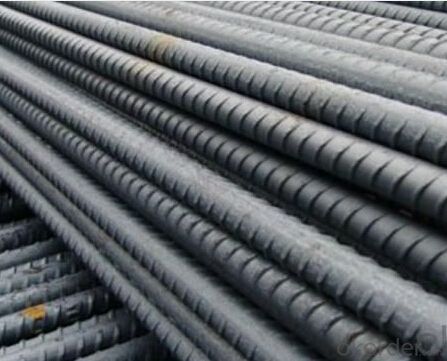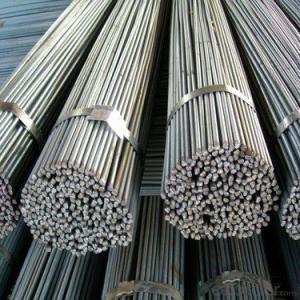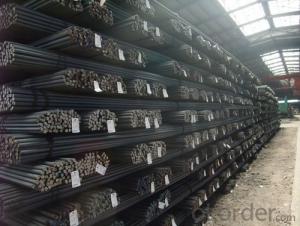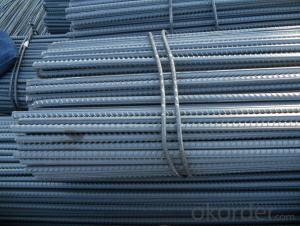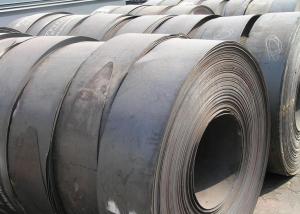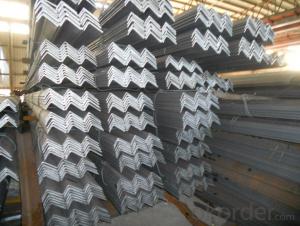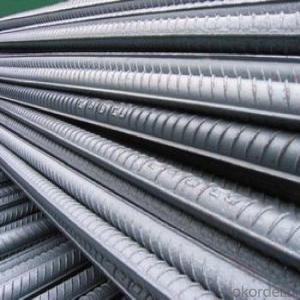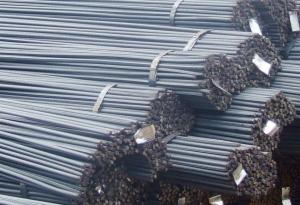GB STANDARD HIGH QUALITY HOT ROLLED STEEL REBAR
- Loading Port:
- Tianjin
- Payment Terms:
- TT OR LC
- Min Order Qty:
- 50 m.t.
- Supply Capability:
- 100000 m.t./month
OKorder Service Pledge
OKorder Financial Service
You Might Also Like
Product Description:
Specifications of Hot Rolled Steel Rebar:
The production process of Steel Rebar
1-Waling beam furnace 2-Roughing rolling group 3-Intermediate rolling train
4-Finishing rolling group 5-Water-cooling device 6-Walking beam cooler
7-Finishing equipment(including the cold scale shear,short feet collection system,
automatic counting device,bundling machine, collect bench)
Usage and Applications of Hot Rolled Steel Rebar:
Deformed bar is widely used in buildings, bridges, roads and other engineering construction. Big to highways, railways, bridges, culverts, tunnels, public facilities such as flood control, dam, small to housing construction, beam, column, wall and the foundation of the plate, deformed bar is an integral structure material. With the development of world economy and the vigorous development of infrastructure construction, real estate, the demand for deformed bar will be larger and larger..
Packaging & Delivery of Hot Rolled Steel Rebar:
Packaging Detail: products are packed in bundle and then shipped by container or bulk vessel, deformed bar is usually naked strapping delivery, when storing, please pay attention to moisture proof. The performance of rust will produce adverse effect.
Each bundle weight: 2-3MT, or as required
Payment terms: TT payment in advance or Irrevocable LC at sight.
Trade terms :FOB, CFR, CIF
Label:to be specified by customer, generally, each bundle has 1-2 labels
Note:
1. Our products are produced according to national standard (GB), if not, supply according to national standards (GB) or agreement as customer required.
2. Other Grade and Standard Deformed Steel Bar we can supply:
Grade: GR40/GR60, G460B/B500A/B500B/B500C,BST500S
Standard: ASTM, BS, DIN
The Minimum Order Quantity of these products is high, and need to be confirmed.
3. We can not only supply Deformed Steel Bar; if you need anything about building materials, please contact us for further information.
4. Please send us your detail specifications when inquire. We will reply to you as soon as possible. We sincerely hope we can establish a long stable business relationship.
- Q: Can steel rebars be used in the construction of railway or subway systems?
- Yes, steel rebars can be used in the construction of railway or subway systems. Steel rebars provide structural reinforcement and strength to the concrete structures used in railway or subway construction, making them essential for ensuring the safety and longevity of these transportation systems.
- Q: Can steel rebars be bent without breaking?
- Certainly, steel rebars possess the remarkable ability to undergo bending without experiencing any fractures. These rebars are engineered using an incredibly resilient and durable material known as steel, which boasts exceptional flexibility and tensile strength. Consequently, steel rebars have the capacity to endure substantial bending forces without succumbing to breakage or fracturing. Nevertheless, it is imperative to bear in mind that there exist limitations to the extent to which a steel rebar can be bent without inflicting damage. In the event that excessive force is applied or if the rebar is bent beyond its maximum bending capacity, it may eventually yield and break. Consequently, it is of utmost importance to meticulously adhere to industry guidelines and specifications when manipulating steel rebars, as this guarantees their structural performance and integrity.
- Q: What are the safety precautions when working with steel rebars?
- When working with steel rebars, it is important to follow several safety precautions to minimize the risk of accidents and injuries. Here are some key safety measures to consider: 1. Personal Protective Equipment (PPE): Always wear the appropriate PPE, including safety glasses or goggles, gloves, steel-toed boots, and a hard hat. This will protect you from potential hazards such as falling objects, flying debris, or accidental contact with sharp edges. 2. Training and awareness: Ensure that all workers involved in handling steel rebars receive proper training on safe work practices and are aware of the potential hazards associated with this work. Regular safety meetings and reminders can help reinforce this knowledge. 3. Proper lifting techniques: Steel rebars can be heavy and awkward to handle. Use proper lifting techniques, such as bending at the knees and lifting with your legs, to avoid strains or back injuries. If necessary, use mechanical lifting aids, such as cranes or hoists, to reduce the physical strain on workers. 4. Secure storage and handling: Store steel rebars in a secure and organized manner to prevent them from falling or rolling onto workers. When moving or transporting rebars, ensure they are properly secured to prevent them from shifting or falling during transit. 5. Cutting and bending precautions: When cutting or bending steel rebars, use appropriate tools and equipment, such as bolt cutters or rebar benders. Always wear protective gloves and ensure that the cutting or bending area is clear of other workers to prevent accidental injuries. 6. Fall protection: When working at heights, such as during the installation of rebars in elevated structures, ensure proper fall protection measures are in place. This may include using safety harnesses, guardrails, or safety nets to prevent falls. 7. Fire prevention: Steel rebars can generate sparks when cut or welded, so it is crucial to have proper fire prevention measures in place. Clear the work area of flammable materials, have fire extinguishers readily available, and follow appropriate welding safety protocols. 8. Regular equipment maintenance: Keep all tools and equipment used for handling steel rebars well-maintained and in good working condition. Regularly inspect them for any damage or defects that could compromise safety. By following these safety precautions, you can create a safer working environment when handling steel rebars and reduce the risk of accidents or injuries.
- Q: Can steel rebars be welded or spliced together?
- Yes, steel rebars can be welded or spliced together. This process involves connecting two or more rebars by either welding them using heat and electricity or by splicing them together using mechanical connectors.
- Q: Can steel rebars be bent without compromising their strength?
- Yes, steel rebars can be bent without compromising their strength if done within their specified bending limits and with proper techniques.
- Q: Can steel rebars be used in railway track construction?
- Yes, steel rebars can be used in railway track construction. They are commonly used as reinforcement in the concrete slabs and foundations of railway tracks to provide strength and durability.
- Q: How do steel rebars prevent cracking in concrete?
- Steel rebars prevent cracking in concrete by providing reinforcement and increasing the overall strength and durability of the structure. When concrete is subject to tensile forces, such as bending or stretching, it tends to crack. However, steel rebars are added to concrete construction to counteract these tensile forces. The rebars, which are made of high-strength steel, are strategically placed within the concrete to create a reinforcing mesh or framework. This mesh acts as a skeleton that absorbs and distributes the tensile forces throughout the concrete structure, preventing the formation of cracks. When external loads, such as heavy weights or seismic forces, are applied to the concrete, the rebars bear the tensile stress instead of the concrete. The steel rebars have a significantly higher tensile strength compared to concrete, allowing them to resist the forces that would normally cause cracking. By distributing the stress more evenly, the rebars minimize the formation of cracks and help maintain the structural integrity of the concrete. Furthermore, steel rebars also prevent cracks by improving the bond between the concrete and the reinforcement. Concrete has excellent compressive strength, but its tensile strength is relatively low. The presence of rebars increases the overall tensile strength of the concrete, making it less likely to crack under tension. The rebars create a bond with the concrete, forming a composite material that can withstand both compressive and tensile forces more effectively. In summary, steel rebars prevent cracking in concrete by providing reinforcement, absorbing tensile forces, and improving the overall strength and durability of the structure. They act as a skeleton within the concrete, distributing stress and preventing the formation of cracks, thereby ensuring the longevity and stability of the concrete construction.
- Q: Can steel rebars be used in historical buildings restoration?
- Yes, steel rebars can be used in the restoration of historical buildings. Steel rebars are commonly used in construction and can provide structural reinforcement to strengthen the existing structures of historical buildings. When carefully implemented, steel rebars can help restore the stability and integrity of these buildings while preserving their historical significance. However, it is important to consider the specific requirements and guidelines for historical building restoration to ensure that the use of steel rebars does not compromise the authenticity or aesthetic value of the structure. Proper planning, consultation with preservation experts, and adherence to conservation principles are essential to successfully incorporate steel rebars in the restoration process of historical buildings.
- Q: What is the role of steel rebars in industrial construction?
- Steel rebars play a crucial role in industrial construction as they provide reinforcement and strength to concrete structures. They are commonly used to reinforce beams, columns, and slabs, enhancing their load-bearing capacity and durability. By preventing cracks and ensuring structural stability, steel rebars help industrial buildings withstand heavy loads, seismic activity, and other external forces, making them a vital component in ensuring the safety and longevity of the construction project.
- Q: Can steel rebars rust or corrode over time?
- Yes, steel rebars can rust or corrode over time if they are exposed to moisture or other corrosive elements.
Send your message to us
GB STANDARD HIGH QUALITY HOT ROLLED STEEL REBAR
- Loading Port:
- Tianjin
- Payment Terms:
- TT OR LC
- Min Order Qty:
- 50 m.t.
- Supply Capability:
- 100000 m.t./month
OKorder Service Pledge
OKorder Financial Service
Similar products
Hot products
Hot Searches
Related keywords



